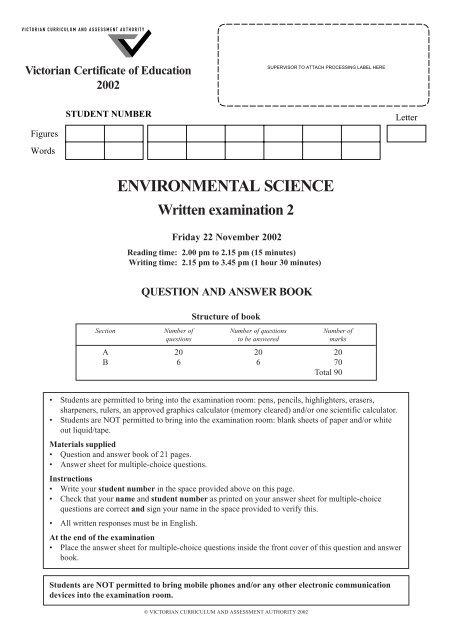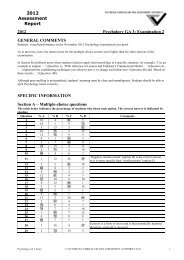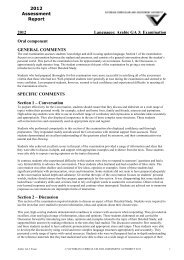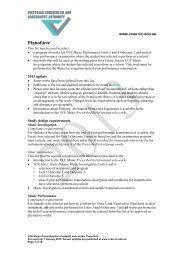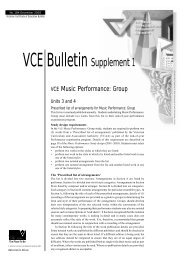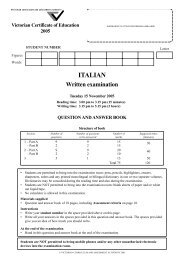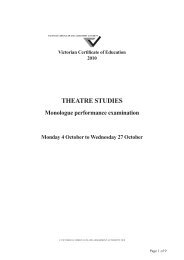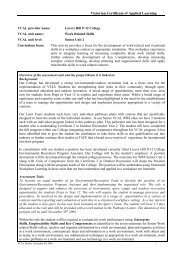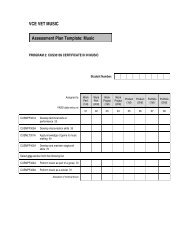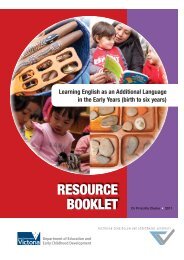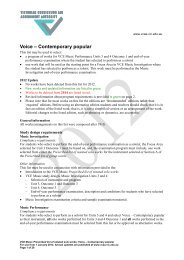Exam 2 - Victorian Curriculum and Assessment Authority
Exam 2 - Victorian Curriculum and Assessment Authority
Exam 2 - Victorian Curriculum and Assessment Authority
You also want an ePaper? Increase the reach of your titles
YUMPU automatically turns print PDFs into web optimized ePapers that Google loves.
<strong>Victorian</strong> Certificate of Education<br />
2002<br />
Figures<br />
Words<br />
ENVIRONMENTAL SCIENCE<br />
Written examination 2<br />
Friday 22 November 2002<br />
Reading time: 2.00 pm to 2.15 pm (15 minutes)<br />
Writing time: 2.15 pm to 3.45 pm (1 hour 30 minutes)<br />
QUESTION AND ANSWER BOOK<br />
Structure of book<br />
SUPERVISOR TO ATTACH PROCESSING LABEL HERE<br />
STUDENT NUMBER Letter<br />
Section Number of Number of questions Number of<br />
questions to be answered marks<br />
A 20 20 20<br />
B 6 6 70<br />
Total 90<br />
• Students are permitted to bring into the examination room: pens, pencils, highlighters, erasers,<br />
sharpeners, rulers, an approved graphics calculator (memory cleared) <strong>and</strong>/or one scientific calculator.<br />
• Students are NOT permitted to bring into the examination room: blank sheets of paper <strong>and</strong>/or white<br />
out liquid/tape.<br />
Materials supplied<br />
• Question <strong>and</strong> answer book of 21 pages.<br />
• Answer sheet for multiple-choice questions.<br />
Instructions<br />
• Write your student number in the space provided above on this page.<br />
• Check that your name <strong>and</strong> student number as printed on your answer sheet for multiple-choice<br />
questions are correct <strong>and</strong> sign your name in the space provided to verify this.<br />
• All written responses must be in English.<br />
At the end of the examination<br />
• Place the answer sheet for multiple-choice questions inside the front cover of this question <strong>and</strong> answer<br />
book.<br />
Students are NOT permitted to bring mobile phones <strong>and</strong>/or any other electronic communication<br />
devices into the examination room.<br />
© VICTORIAN CURRICULUM AND ASSESSMENT AUTHORITY 2002
ENVSC EXAM 2 2<br />
SECTION A – Multiple-choice questions<br />
Instructions for Section A<br />
Answer all questions in pencil on the answer sheet for multiple-choice questions.<br />
A correct answer scores 1, an incorrect answer scores 0. Marks will not be deducted for incorrect<br />
answers. No mark will be given if more than one answer is shown for any question.<br />
Question 1<br />
A diffuse source of a pollutant is best described as a source<br />
A. which requires a secondary transport material to spread the pollutant.<br />
B. where there is no single point at which the pollutant enters the environment.<br />
C. where the pollutant is spread through the environment by w<strong>and</strong>ering animals.<br />
D. where the pollutant is spread evenly from a point to cover the entire environment.<br />
Question 2<br />
The term persistence of a pollutant in the environment refers to the<br />
A. concentration of the pollutant in the environment.<br />
B. distance a pollutant spreads in the environment in a given time.<br />
C. length of time required for the pollutant to disappear from the environment.<br />
D. measure of the harm a substance can cause to humans <strong>and</strong> other living organisms in the environment.<br />
Use the following information to answer Questions 3–6.<br />
A truck carrying a toxic chemical crashes off the side of a bridge over a large lake, <strong>and</strong> the whole load spills into<br />
the lake. The chemical is a highly volatile liquid (evaporates very easily).<br />
Question 3<br />
This spill would be considered an example of<br />
A. a point source.<br />
B. a pollutant sink.<br />
C. a diffuse source.<br />
D. bioaccumulation.<br />
Question 4<br />
The high volatility of the spilt chemical is likely to directly reduce its<br />
A. toxicity.<br />
B. persistence.<br />
C. bioaccumulation.<br />
D. absorption by humans.<br />
SECTION A – continued
3 ENVSC EXAM 2<br />
Question 5<br />
Which one of the following represents a pollutant sink for the toxic chemical?<br />
A. evaporation <strong>and</strong> dispersion by wind into the atmosphere<br />
B. the truck that carried the toxic chemical<br />
C. persistence of the chemical within the lake ecosystem<br />
D. future replacement by industry of the toxic chemical with more environmentally friendly products<br />
Question 6<br />
A likely transport mechanism for this pollutant could be<br />
A. parasitic.<br />
B. waterborne.<br />
C. spread by birds.<br />
D. bioaccumulation.<br />
Question 7<br />
Life Cycle Analysis aims to quantify<br />
A. an estimate of the acceptable risk to human life.<br />
B. the effect of the pollutant on a living organism.<br />
C. the impact of the pollutant on a particular ecosystem.<br />
D. all impacts of the pollutant <strong>and</strong> its products over its entire time cycle.<br />
Question 8<br />
A train carrying mixed freight is derailed. The application of the Precautionary Principle would require that, in<br />
this situation, we<br />
A. leave the train where it is until all the cargo has rotted away.<br />
B. assume some of the cargo may be toxic until we have details of the train’s cargo list.<br />
C. send in teams of workers immediately to remove all freight as a precaution against toxicity.<br />
D. take no precautions to protect the environment until it is certain that there are pollutants on the train.<br />
SECTION A – continued<br />
TURN OVER
ENVSC EXAM 2 4<br />
Use the following information to answer Questions 9 <strong>and</strong> 10.<br />
A scientist was studying a stream in a mountain area in which gold mining <strong>and</strong> processing had taken place in<br />
previous years. She measured the concentration of cyanide (a substance used in extracting gold) at a particular<br />
point in the stream, taking readings over several years. The measure of concentration is ppm (parts per million)<br />
or the equivalent unit, μg per g by mass. 1 μg = 10 –6 g. Her data is shown in the graph below.<br />
concentration<br />
(ppm)<br />
0.6<br />
0.5<br />
0.4<br />
0.3<br />
0.2<br />
0.1<br />
0<br />
1990 1991 1992 1993 1994 1995 1996 1997 1998 1999 2000 2001<br />
time (year)<br />
Figure 1. Concentration of cyanide (ppm) versus time (year)<br />
Question 9<br />
What was the change in concentration between 1991 <strong>and</strong> 1994?<br />
A. 0.1 ppm<br />
B. 0.2 ppm<br />
C. 0.4 ppm<br />
D. 0.5 ppm<br />
The acceptable concentration of cyanide in water for human consumption in this region is less than 0.1 ppm.<br />
Question 10<br />
In what year could the stream, at that point, be allowed to be first used safely for drinking water?<br />
A. 1991<br />
B. 1995<br />
C. 2000<br />
D. never; cyanide is a toxic heavy metal<br />
SECTION A – continued
5 ENVSC EXAM 2<br />
Question 11<br />
Which one of the following is an example of the process of bioaccumulation?<br />
A. decline of ecosystem function because the level of a pollutant increases<br />
B. development of cancer in a person because they ingested a toxic pesticide<br />
C. failure of an organism to reproduce successfully because they consumed a pollutant<br />
D. increase in the amount of chemical in a shellfish because the rate of intake exceeds the rate of removal<br />
Question 12<br />
A development is ecologically sustainable if it<br />
A. does not cause the extinction of any species.<br />
B. conforms to environmental regulatory frameworks.<br />
C. minimises the amount of soil contamination occurring.<br />
D. can be maintained indefinitely without degradation of the ecosystem.<br />
Question 13<br />
Which one of the following approaches would result in ecologically sustainable development of Victoria’s<br />
native forests?<br />
A. a complete ban on logging<br />
B. logging permitted only when there is a strong dem<strong>and</strong> for wood<br />
C. logging permitted only every second year<br />
D. logging limited to the rate of regrowth<br />
Question 14<br />
The main function of Regulatory Frameworks should be to attempt to<br />
A. balance community needs against environmental damage.<br />
B. reduce the environmental impact of developmental projects to zero.<br />
C. give local communities complete control over major projects in their region.<br />
D. provide sufficient checks themselves, so that local community consultation is not needed.<br />
SECTION A – continued<br />
TURN OVER
ENVSC EXAM 2 6<br />
Use the following information to answer Questions 15–17.<br />
Environmental management strategies must be developed to ensure the ecological sustainability of the<br />
environment. These are developed by regulatory agencies such as national parks services.<br />
A species of shrub in a national park will not reproduce successfully unless there is sufficient viable* seed<br />
when a fire occurs. The amount of viable seed initially increases with time since the last fire <strong>and</strong> then declines.<br />
This is shown in Figure 2 below.<br />
The national park is managed with the aim of ensuring that there is an appropriate ‘fire interval’ in places where<br />
the shrub exists. A fire interval is the time in years between two successive fires.<br />
* viable = capable of living<br />
viable seeds<br />
per hectare<br />
100 000<br />
80 000<br />
60 000<br />
40 000<br />
20 000<br />
O 20 40<br />
fire interval (in years)<br />
60 80<br />
Figure 2. Number of viable shrub seeds per hectare versus time (in years) since last fire<br />
Question 15<br />
Studies show that the shrub needs at least 20 000 viable seeds per hectare for the species to reproduce successfully.<br />
Using the data in the above graph (Figure 2), which of the following fire intervals would allow the species to<br />
reproduce successfully?<br />
A. 15 years<br />
B. 30 years<br />
C. 55 years<br />
D. 65 years<br />
SECTION A – continued
7 ENVSC EXAM 2<br />
Question 16<br />
The habitat of this shrub may be invaded by a weed species. The number of viable seeds per hectare produced<br />
by this weed is shown in the graph below. This weed also requires 20 000 seeds per hectare to reproduce<br />
successfully.<br />
viable seeds<br />
per hectare<br />
100 000<br />
80 000<br />
60 000<br />
40 000<br />
20 000<br />
O 20 40<br />
fire interval (in years)<br />
60 80<br />
Figure 3. Number of viable weed seeds per hectare versus time (in years) since last fire<br />
Using the above graph (Figure 3), which of the following fire intervals would ensure that reproduction of the<br />
weed was not successful?<br />
A. 20 years<br />
B. 40 years<br />
C. 60 years<br />
D. 80 years<br />
Question 17<br />
Using both graphs (Figures 2 <strong>and</strong> 3), which of the following fire intervals would allow the shrub to reproduce<br />
successfully, but would prevent the successful regeneration of the weed?<br />
A. 15 years<br />
B. 30 years<br />
C. 45 years<br />
D. 60 years<br />
SECTION A – continued<br />
TURN OVER
ENVSC EXAM 2 8<br />
Question 18<br />
Acid sulfate soils can occur naturally in the environment near river mouths. These soils contain higher than<br />
normal levels of metal sulfides. Exposure of these metal sulfides to oxygen in a moist environment can generate<br />
unsatisfactory levels of sulfuric acid.<br />
A swampy site next to a river mouth has just been identified as having acid sulfate soil. The Environmental<br />
Management Plan for this site could involve<br />
A. introducing a species of animal which can survive in an acidic environment.<br />
B. treatment with a suitable chemical to reduce the acidity.<br />
C. planting exotic salt-tolerant trees <strong>and</strong> shrubs.<br />
D. turning the site over to intensive agriculture.<br />
Question 19<br />
In a recent study 200 people wore small air pollution monitors for five days in winter <strong>and</strong> again in summer. The<br />
study was designed to assess personal exposure to a range of air pollutants.<br />
In a study of this type, exposure is defined as<br />
A. the number of pollutants studied.<br />
B. the total number of people involved.<br />
C. the total air pollution that all Australians would experience.<br />
D. how much of the pollutants people were exposed to over the 10 days.<br />
Question 20<br />
A company applies to the government for permission to build a new factory to manufacture chemicals near a<br />
city. The government decides to undertake an Environmental Risk <strong>Assessment</strong>.<br />
The main objective of the Environmental Risk <strong>Assessment</strong> is to determine<br />
A. whether the chemical factory is likely to be economical.<br />
B. a complete list of all pollutants that the factory might release.<br />
C. the damage that the factory might do to people <strong>and</strong> the environment.<br />
D. the conditions under which the factory will be given an operating license.<br />
END OF SECTION A
9 ENVSC EXAM 2<br />
This page is blank<br />
TURN OVER
ENVSC EXAM 2 10<br />
SECTION B – Short-answer questions<br />
Instructions for Section B<br />
Answer all questions in the spaces provided.<br />
Question 1<br />
Use one pollutant you have studied to answer the following questions.<br />
a. Briefly describe the pollutant.<br />
b. Give details of the source or sources of this pollutant.<br />
2 marks<br />
2 marks<br />
c. Explain how this pollutant enters <strong>and</strong> is distributed through the environment (its transport mechanism).<br />
3 marks<br />
SECTION B – Question 1 – continued
11 ENVSC EXAM 2<br />
d. Describe the pollutant’s impact on humans, the natural environment or both. State one population class on<br />
which the selected pollutant has an adverse impact. Describe this impact.<br />
3 marks<br />
e. No specific action was taken by humans to remove the pollutant. Describe how the pollutant would naturally<br />
become degraded or removed from the environment.<br />
Include a comment on its persistence in your answer.<br />
3 marks<br />
f. Describe a strategy for reducing the impact of this pollutant on the health of the chosen population. Estimate<br />
its effectiveness or potential effectiveness.<br />
3 marks<br />
SECTION B – continued<br />
TURN OVER
ENVSC EXAM 2 12<br />
Question 2<br />
For 50 years, an isolated industrial factory has released into the environment a range of pollutants, including<br />
sulfur dioxide <strong>and</strong> small particles of lead (a heavy metal).<br />
The pollutants are all carried into the atmosphere in hot gases emitted from a tall chimney. Sulfur dioxide<br />
dissolves easily in water. Lead does not dissolve in water <strong>and</strong> will last for a long time in soil.<br />
To check the industrial factory’s environmental impact, scientists undertook extensive sampling of soil to a<br />
distance of 10 kilometres around the factory.<br />
Figure 4 shows soil concentrations of lead due to emissions from the factory. Darker areas show higher lead<br />
concentrations. Lighter areas show lower concentrations, with white areas showing no measurable lead.<br />
Concentrations of sulfur dioxide at ground level were measured for a year at locations around the factory. The<br />
average concentrations of sulfur dioxide measured at each location are shown as a number on the diagram in<br />
ppm (parts per million).<br />
Prevailing wind is from west to east.<br />
W<br />
5.2<br />
7.4<br />
N<br />
S<br />
E<br />
1.8<br />
0.4<br />
0.2<br />
factory<br />
(not to scale)<br />
Figure 4. Distribution of lead <strong>and</strong> sulfur dioxide<br />
a. Give an explanation for the observed distributions of sulfur dioxide <strong>and</strong> lead around the factory. In your<br />
answer, refer to transport mechanisms <strong>and</strong> the characteristics of the two pollutants. You should also refer<br />
to probable local weather conditions which may have affected the distribution.<br />
2.0<br />
higher lead concentration<br />
lower lead concentration<br />
no measurable lead concentration<br />
10.6<br />
16.3<br />
14.0<br />
18.6<br />
4 marks<br />
SECTION B – Question 2 – continued
13 ENVSC EXAM 2<br />
b. Animals living in the area of the industrial factory were found to have lead concentrations in their bodies<br />
100 times that of the plants growing in the soil where lead concentrations are highest. Discuss the reasons<br />
for this finding.<br />
2 marks<br />
c. The factory closes. Describe the changes that you would expect to find one year later if you repeated all the<br />
measurements of sulfur dioxide <strong>and</strong> lead concentrations.<br />
2 marks<br />
SECTION B – continued<br />
TURN OVER
ENVSC EXAM 2 14<br />
Question 3<br />
A group of students constructs a laboratory model of a pollution spill. They use (coloured) methylated spirits to<br />
simulate the pollutant. A tank of water of volume 10 litres is used to simulate a lake. Methylated spirits mixes<br />
easily with water; <strong>and</strong> is much more volatile (evaporates much more easily into air) than water.<br />
Figure 5 shows the model. Methylated spirits can be added either by directly pouring into the water or by using<br />
a slow drip-feed set up in one corner of the tank as shown in Figure 5 below.<br />
drip-feed<br />
Figure 5<br />
a. Does the drip-feed act as a point or diffuse pollutant source? Give reasons for your answer.<br />
X<br />
1 litre (l) of water has a mass of 1 kg = 1000 g<br />
1 μg = 10 –6 g<br />
2 marks<br />
b. In a second experiment the students add 10 g of methylated spirits, spreading it evenly through the whole<br />
volume. Calculate the immediate concentration in ppm or μg per g. Show working <strong>and</strong> units.<br />
3 marks<br />
SECTION B – Question 3 – continued
15 ENVSC EXAM 2<br />
In a third experiment, the students drip-feed methylated spirits into the tank from the corner drip-feed over a<br />
long period. They measure the concentration at a point, X, at the centre of the tank. Figure 6 below shows the<br />
concentration at X over the time period.<br />
concentration<br />
at X (ppm)<br />
600<br />
500<br />
400<br />
300<br />
200<br />
100<br />
O<br />
24 48<br />
time (hours)<br />
Figure 6<br />
c. Explain the graph (Figure 6) in terms of pollutant characteristics – source, transport mechanism, dissipation<br />
mechanism (removal from the tank).<br />
d. Describe a real-life situation which this experiment could be modelling.<br />
72 96<br />
3 marks<br />
3 marks<br />
SECTION B – continued<br />
TURN OVER
ENVSC EXAM 2 16<br />
Question 4<br />
During your study of Environmental Science this year, you have studied at least one major environmental<br />
project <strong>and</strong> assessed its impact <strong>and</strong> the strategies for reducing this impact. Use either this project or one other<br />
project to answer the following questions.<br />
a. Briefly describe the project.<br />
b. Describe the environmental impacts <strong>and</strong> risks associated with the project.<br />
2 marks<br />
3 marks<br />
c. Outline the management procedures used to assess the environmental risks <strong>and</strong> impacts. Your answer<br />
should include reference to groups consulted.<br />
3 marks<br />
SECTION B – Question 4 – continued
17 ENVSC EXAM 2<br />
d. Outline the Environmental Management Plan developed to minimise the impact of the project on the<br />
environment, both during the planning <strong>and</strong> construction phase, <strong>and</strong> during the life cycle of the project.<br />
Include steps taken to monitor the environmental impact of the project.<br />
4 marks<br />
e. Can this project be correctly described as ‘ecologically sustainable’? Give a reason for your answer.<br />
2 marks<br />
f. Estimate the success (or potential success) of the strategies used to minimise any adverse environmental<br />
impact of the project.<br />
3 marks<br />
SECTION B – continued<br />
TURN OVER
ENVSC EXAM 2 18<br />
Question 5<br />
A new section of freeway is to be built across hilly, open country in rural Victoria. The construction will require<br />
the excavation of cuttings through the ridges. The excavated material will be used to construct embankments<br />
across the lowest areas in the valleys. Two bridges are needed to cross a major river.<br />
The main construction offices <strong>and</strong> workshop will be located on a large cattle farm. The freeway will pass<br />
through this farm. No native habitat remains on this farm. The trees in the windbreaks are European pines <strong>and</strong><br />
the pasture has been improved by over-sowing with imported grass species. Construction of this section of<br />
freeway is scheduled to take about 36 months.<br />
The aims of the Environmental Management Plan for this construction project are to<br />
• minimise l<strong>and</strong> disturbance<br />
• minimise the erosion of soil, particularly on river banks <strong>and</strong> hillsides<br />
• control sediment run-off into the local water-courses<br />
• rehabilitate the site on completion of construction.<br />
The ground over which the freeway is to be built will be stripped of its topsoil so that this soil can be used for<br />
rehabilitation purposes. Once construction has started <strong>and</strong> the topsoil has been stripped off the construction<br />
area, it will need to be stockpiled for about 30 months before the rehabilitation* work begins.<br />
*Rehabilitation: Restore disturbed areas as closely as possible to their original state.<br />
a. Dust <strong>and</strong> sediment in stormwater run-off should be minimised during construction. Describe the operation<br />
of two measures that could be implemented to manage the soil stockpiles.<br />
Measure 1<br />
Measure 2<br />
4 marks<br />
SECTION B – Question 5 – continued
19 ENVSC EXAM 2<br />
b. What measures could the construction company take to protect the ecology of the local water-courses?<br />
4 marks<br />
SECTION B – continued<br />
TURN OVER
ENVSC EXAM 2 20<br />
Question 6<br />
Melbourne Water has a policy of ‘closed catchments’ for almost all of its water supply dams. This means no<br />
human access or activity is permitted in the dams or their catchment areas.<br />
A local council, backed by its community, argues that a medium-size dam, part of Melbourne’s water supply,<br />
should be opened to limited <strong>and</strong> controlled recreational activities.<br />
The arguments put forward by the council include:<br />
• Its region is an economically poor area, with high unemployment; tourism is its only asset <strong>and</strong> potential<br />
income. The dam <strong>and</strong> its surrounds are vital for tourism.<br />
• Modern monitoring, control <strong>and</strong> filtration processes make it safe to allow limited access. Most water<br />
supply authorities throughout the world, including other Australian cities, allow limited usage around<br />
their dams.<br />
The activities suggested by different groups in the local community include:<br />
· picnicking on the shores<br />
· bushwalking, with or without overnight camping allowed<br />
· water-skiing<br />
· non-powered boating (that is, sailing <strong>and</strong> rowing)<br />
· swimming<br />
· horse riding<br />
a. List <strong>and</strong> discuss two issues that should be addressed in an Environmental Impact <strong>Assessment</strong> of this<br />
proposal.<br />
Factor 1<br />
Factor 2<br />
4 marks<br />
SECTION B – Question 6 – continued
21 ENVSC EXAM 2<br />
b. Name one potential pollutant that might be introduced by one or more of the activities put forward by<br />
community groups. Discuss the possible environmental impact.<br />
2 marks<br />
c. Describe a suitable process for decision-making in this case. What bodies or organisations should be<br />
involved?<br />
d. Outline one argument for <strong>and</strong> one against the proposal.<br />
For<br />
Against<br />
END OF QUESTION AND ANSWER BOOK<br />
2 marks<br />
2 marks


